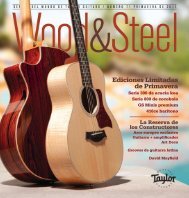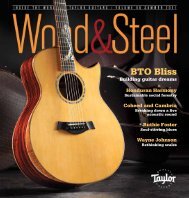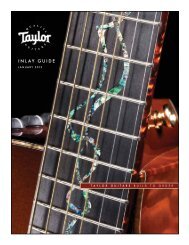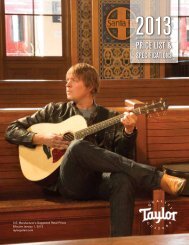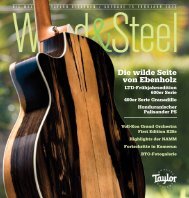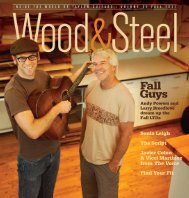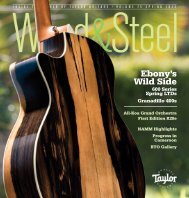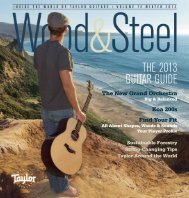You also want an ePaper? Increase the reach of your titles
YUMPU automatically turns print PDFs into web optimized ePapers that Google loves.
7<br />
“<br />
E<br />
veryone has their stories,”<br />
asserts longtime <strong>Taylor</strong><br />
ambassador Doyle Dykes<br />
in that sweet Southern lilt of his, the<br />
kind that can make a complete stranger<br />
instantly feel like a dear friend. The<br />
one-man guitar orchestra certainly<br />
has plenty of colorful tales to share,<br />
which he delivers with a raconteur’s<br />
warm, inviting manner, as many people<br />
know from <strong>Taylor</strong> workshops, concerts,<br />
church services and conversations<br />
over the years. The only problem is<br />
that Doyle’s heavy touring and busy<br />
schedule leave him with limited time<br />
during each appearance.<br />
“I rarely ever have the opportunity<br />
to visit and share my heart,” he<br />
confesses in the introduction to his new<br />
book. “As far as I’m concerned, that’s<br />
what this book is for.”<br />
The book is The Lights of Marfa:<br />
One of the World’s Great Guitar<br />
Player’s Amazing Encounters with<br />
God. The subject matter, as the title<br />
suggests, is both musical and religious,<br />
because the two have been deeply<br />
intertwined in Doyle’s life for a long<br />
time. Music is his gift, but he’ll tell you<br />
that God came first, and that the two<br />
are a package deal. In his book, Doyle<br />
shares an account of the summer<br />
revival he attended as an 11-year-old<br />
in 1965, when his passions for God<br />
and guitars were born. In exchange for<br />
the guitar-playing talent and desire he<br />
was given, he made a deal: “Lord, if<br />
you’ll give me a job to do I’ll always tell<br />
people about you,” he recalls pledging<br />
that summer night. Given Doyle’s<br />
soon-to-blossom fingerstyle prowess,<br />
his account almost sounds like a<br />
reverse take on iconic bluesman Robert<br />
Johnson’s mythical crossroads deal<br />
with the devil.<br />
The metaphorical glue that binds<br />
the book’s stories are the Marfa lights,<br />
a mercurial phenomenon just east of<br />
the west Texas town of Marfa, in which<br />
lights inexplicably appear in the desert<br />
air on random nights, changing color,<br />
sometimes spinning and dancing, only<br />
to disappear. Though different theories<br />
have been floated to scientifically<br />
explain them, they remain a mysterious<br />
attraction. Likewise, Doyle’s stories<br />
key in on remarkable encounters, often<br />
chance meetings with strangers — a<br />
sailor, a state trooper, a soldier, a<br />
hospital president, a doctor on a plane,<br />
even Elvis Presley (although that was<br />
technically a non-encounter). For Doyle,<br />
the strange coincidences of these<br />
connections, like the Marfa lights, can’t<br />
be explained in a conventional way,<br />
and he relates them to the mystery of<br />
religious faith that illuminates his life.<br />
Doyle says he was approached<br />
about writing a book five years ago<br />
by Moody Publishers, whose editorial<br />
focus is the Christian sector.<br />
“It was a back burner thing,” he<br />
says. “Every now and then I’d get on<br />
a plane and write a few things down,<br />
familiar things like the ‘White Rose for<br />
Heidi’ story, but I didn’t take it seriously<br />
until [last February] when Bob <strong>Taylor</strong><br />
told me about Marfa. I actually sat<br />
down and wrote, ‘The Lights of Marfa,<br />
by Doyle Dykes,’ and then wrote the<br />
whole introduction before I had ever<br />
gone out to see Marfa yet, so I knew<br />
the concept was there.”<br />
Like Bob <strong>Taylor</strong>’s book, Doyle’s<br />
format is less a straight autobiography<br />
and more a collection of personal<br />
stories. The tales do follow the<br />
trajectory of Doyle’s early life, painting<br />
a picture of his conservative Christian<br />
upbringing in Jacksonville, Florida,<br />
and the way family, faith, and music all<br />
blended together in his young life.<br />
“In our house, hardly a day went<br />
by that we didn’t hear the music of<br />
Chet Atkins, Merle Travis, and Les<br />
Paul and Mary Ford on the stereo,” he<br />
writes. His father, “Bubba” Dykes, sang<br />
and played guitar, his mother sang<br />
at church, and Doyle and his brother<br />
Aubrey would join their parents to sing<br />
four-part harmony around a microphone<br />
at church. His dad loved gospel quartet<br />
music, and it would surely be a proud<br />
moment years later when Doyle would<br />
join the Stamps Quartet as a guitarist.<br />
Regardless of your religious<br />
persuasion, if you’re a fan of Doyle’s,<br />
reading his perspective on how faith<br />
has guided his life offers compelling<br />
insights into who he is and provides<br />
context for his fusion of the sacred<br />
and secular through music. At the end<br />
of each chapter, he cites his favorite<br />
scripture verses that relate, though he’s<br />
just as likely to include musical tidbits<br />
like his favorite guitars, players and<br />
tunings for particular songs.<br />
Guitar fans will enjoy reading about<br />
Doyle’s early musical development.<br />
In one chapter, he recalls suffering<br />
through piano lessons as a boy, but<br />
also of the impact of those lessons on<br />
the fingerstyle guitar techniques he<br />
would later master.<br />
“I didn’t realize the direct correlation<br />
with piano until years later,” he<br />
elaborates by phone. “Merle Travis told<br />
me he was just a honky tonk piano<br />
player on the guitar. And I remember<br />
Chet [Atkins] saying, ‘I’m just playing<br />
stride piano,’ where he’s playing the<br />
1 then the chord, then the 5 then the<br />
chord. The way Merle was doing it was<br />
similar, but it was more like this lady<br />
who used to play at the Grand Ole<br />
Opry, Del Wood. My aunt played much<br />
like Del, just with a little lighter touch. I<br />
always admired that, and the dynamics<br />
that my Uncle Ronnie would get [on<br />
piano]; he was our Jerry Reed. In fact,<br />
I was talking to Merle’s son, Thom<br />
Bresh, and he said, ‘Y’know, Jerry Reed<br />
always said that instead of a piano<br />
player he played like a gospel organist,’<br />
which is a whole different approach<br />
on the keyboard. When I wrote ‘Jazz in<br />
the Box,’ I wrote that in the same way,<br />
as far as the feel…kind of a gospel,<br />
sawdust-and-folding-chairs tent revival<br />
on the organ. That’s where all that<br />
came from.”<br />
One of the book’s most touching<br />
chapters is the story of Barry Lackey, a<br />
guitar-picking sailor who fatefully met<br />
Doyle’s dad at church, was invited to<br />
the Dykes house for a home-cooked<br />
meal, and in one afternoon changed<br />
14-year-old Doyle’s life forever by<br />
showing him the mechanics of Travisstyle<br />
picking. Though Doyle had been<br />
listening to Merle and Chet, he’d never<br />
actually seen how they played.<br />
“When Barry was playing and I saw<br />
the bass and the rhythm going at the<br />
same time as the melody, that’s when I<br />
understood what was going on for the<br />
first time,” Doyle says. “I’d been trying<br />
to do that with a flatpick. It turned the<br />
light on for sure.”<br />
Part of what makes the book<br />
enjoyable is the natural, conversational<br />
way that Doyle’s personality and voice<br />
come through as he shares his soul<br />
— his Southern charm, his sense of<br />
humor, his depth of conviction, and<br />
his deep respect for the legendary<br />
musicians who influenced him, many<br />
of whom he was fortunate to develop<br />
friendships with.<br />
Doyle reflects on his time playing<br />
with Hee Haw star Grandpa Jones and<br />
his guest appearances on the Grand<br />
Ole Opry; the period he spent away<br />
from music working as a church pastor<br />
in Florida; his return to music as a fulltime<br />
profession; and his first visit to the<br />
<strong>Taylor</strong> factory in 1994, which would<br />
redirect his approach to the guitar.<br />
Because Doyle is best-known as an<br />
acoustic player, it’s easy to forget that<br />
he was predominantly an electric player<br />
up until then.<br />
“I’ll never forget that first <strong>Taylor</strong><br />
guitar they placed in my hands,”<br />
Doyle recalls in his chapter about<br />
the beginning of his relationship with<br />
the company. “I almost cried.” That<br />
experience would cause him to change<br />
his whole approach to playing. “The<br />
dynamics and clarity, as well as the<br />
versatility…and ease of playing, moved<br />
me to write new songs and even play<br />
differently. People took notice.” He<br />
sums things up thusly a little later: “I<br />
don’t play a <strong>Taylor</strong> because I play the<br />
acoustic guitar, but I play the acoustic<br />
guitar because of <strong>Taylor</strong>!”<br />
Doyle reserves a chapter of the<br />
book (“Hero Sandwich”) to talk about<br />
the special relationships he has enjoyed<br />
with some of the guitar world’s most<br />
influential players, including the “big<br />
three”: Merle Travis, Chet Atkins, and<br />
Les Paul, along with longtime friends<br />
James Burton and Duane Eddy. While<br />
he acknowledges that meeting one’s<br />
heroes is a letdown for many, it wasn’t<br />
for him.<br />
Doyle even wrote and recorded<br />
a theme song of sorts for the book,<br />
inspired by his trip to Marfa. It’s part<br />
of a companion DVD that comes with<br />
the book.<br />
“When I first started the song, I was<br />
writing this sort of ethereal-sounding,<br />
out-there, John Fahey type thing,” he<br />
says. “So I thought, what is Marfa?<br />
Where is Marfa? How would I describe<br />
Marfa? The whole west Texas thing<br />
came to me, and I thought, I’ll do it like<br />
a Texas movie theme because Giant<br />
was filmed there, and No Country For<br />
Old Men and There Will Be Blood<br />
were shot in that same area.”<br />
continued next page




